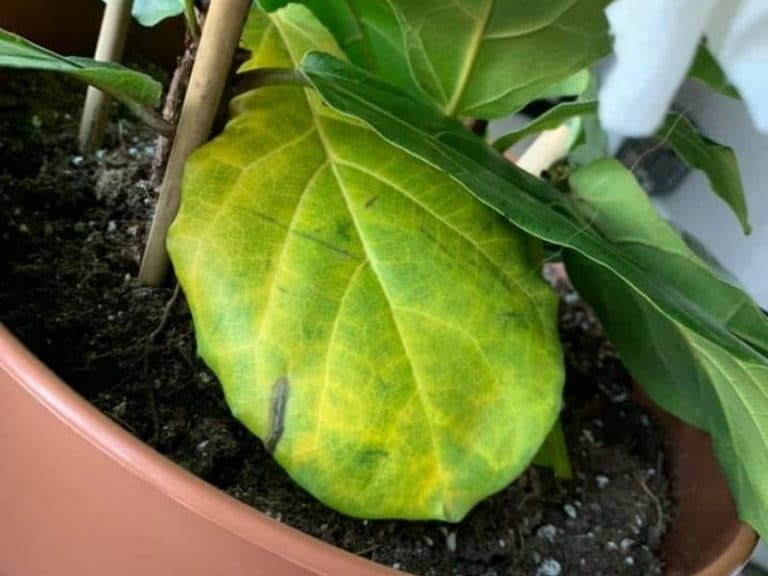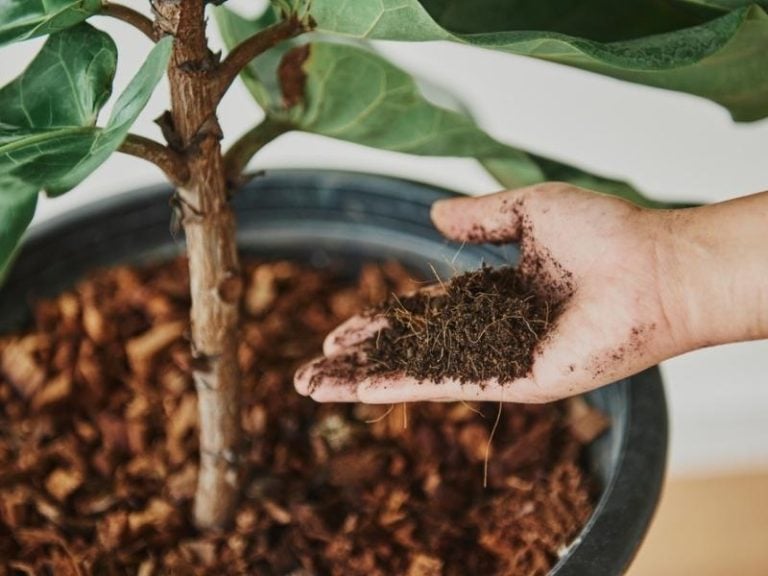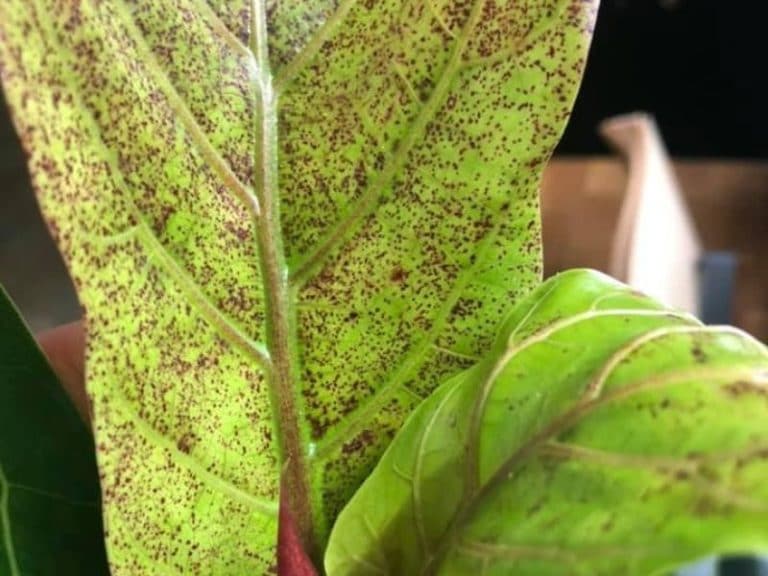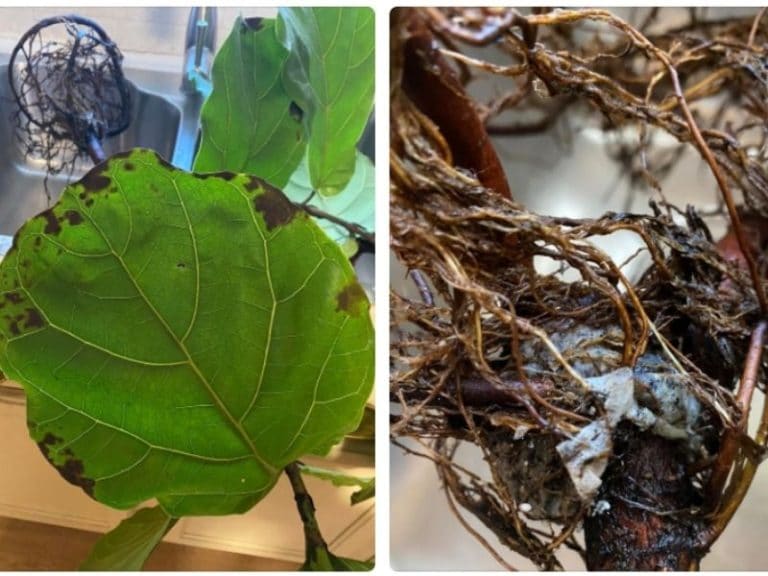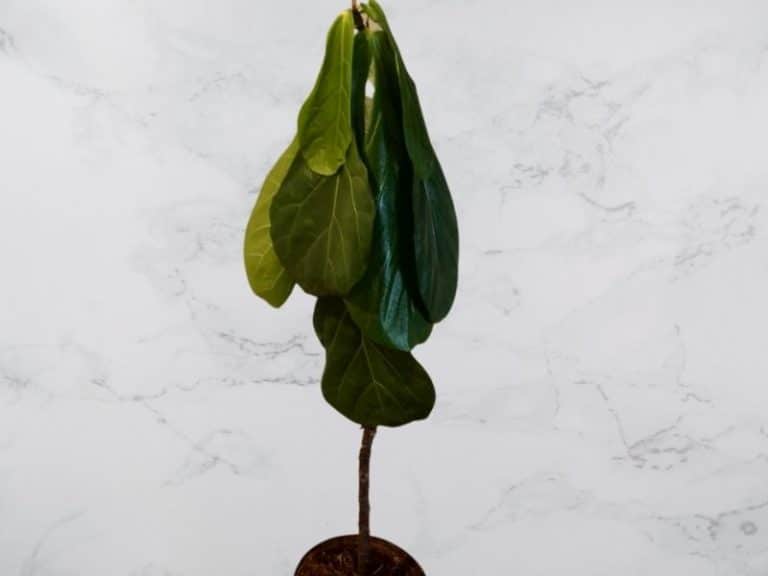Red Spots on Fiddle Leaf Fig (Edema) – Causes and Fixes
The most likely culprit whenever red spots appear on fiddle leaf fig plants is edema. This plant disorder is common in such ornamental plants and is caused by moisture stress within the leaf cells. To fix edema and get rid of the red spots, you should adopt a proper watering regimen and ensure proper drainage in the soil.
What causes tiny red spots on fig leaves?
The most common cause of tiny red spots on fiddle leaf figs is edema, which is a cosmetic problem triggered by moisture stress. Spider mite damage, bacterial infection, fungal infection, and underwatering may also cause your Ficus lyrata to spot red dots; though not as often as edema.

Note that the focus of this blog is the tiny, red pockmarks caused by edema. Thus, only the causes of edema are discussed.
Moisture imbalance
Edema is a physiological disorder that appears as small, red bumps or pockmarks on the leaf surface of affected plants. It occurs due to moisture stress/imbalance in the leaf cells. In fiddle leaf figs, edema is usually more evident on the younger leaves.
Sometimes, the leaf cells of fiddle leaf figs take in moisture from the roots at a faster rate than they can transpire. This is more likely to happen when the soil is overwatered. As the water-soaked leaf cells swell, they burst and the plant tissue surrounding the blisters turns red as the wound closes.
Planting Ficus lyrata in a pot with poor drainage, or a compact soil mix with poor drainage/aeration also facilitates the onset of edema. Since water is retained around the plant’s roots for longer in such conditions, the roots absorb moisture at a faster rate.
Note: While moisture imbalance is the primary cause of edema, other factors may also fast-track the advent of this plant disorder as highlighted below.
Low light intensity
Low light conditions affect the ability of fiddle leaf figs to photosynthesize. The result is diminished plant energy. With lesser energy, your Ficus lyrata’s natural defenses are weakened, consequently heightening the plant’s susceptibility to edema.
High humidity
When relative humidity levels are high (above 60%), fig leaves transpire at a slower rate, as the surrounding air can only take in so much water. This creates the perfect environment for leaf cell moisture imbalance, resulting in edema. Planting fiddle leaf figs close to one another also increases the relative humidity around the leaf surface.
Low temperature levels
When temperature levels are low (below 60-degrees Fahrenheit) and the air is cold, the rate of transpiration reduces. If this condition is combined with high soil moisture levels, your fiddle leaf fig plant becomes more susceptible to moisture imbalance leading to edema.
Low mineral concentration
When plant mineral levels are low, its natural defenses against disorders like edema are lowered. This problem is usually triggered by underwatering, whereby the root zone becomes too dry to properly take in the necessary minerals.
How to Fix Red Spots on Fiddle Leaf Fig
To get rid of red spots (edema) on your fiddle leaf fig, modify your watering cycle. Repotting the plant in a fresh soil mix and growing container with proper drainage will also help to fix the problem.
Here’s how to treat red spots on fiddle leaf figs:
1. Modify your watering cycle
You can make edema red spots on your Ficus lyrata disappear by adjusting your irrigation patterns according to the environmental conditions and the plant’s growth stage. For instance, during winter, it’s advisable to water less often. That’s because fiddle leaf fig leaves transpire slower during this time of the year due to the cold temperatures.
You should also lower your irrigation frequency if the relative humidity level is high. This will lower the chances of moisture imbalance within the plant’s leaf cells. Once the soil moisture levels reduce, the red spots on the plant foliage caused by edema will slowly disappear.
Meanwhile, if edema red spots appear during the growing season (spring-summer for fiddle leaf figs), you should stick to your current irrigation schedule, or slightly lower the frequency of watering if you have to to prevent problems like root rot in your fiddle leaf figs.
That’s because Ficus lyrata usually sprouts new leaves in abundance at this time of the year, thus requiring extra moisture. It makes more sense to risk mild edema than to underwater your plant and risk harming new foliage growth.
Finally, you should water your fiddle leaf fig in the morning to allow most of the water to drain by nightfall when temperatures are lower and relative humidity is higher. This practice also helps prevent bacterial infections on fiddle leaf figs.
2. Repot in a fast-draining soil mix
Even with a balanced irrigation schedule, the soil in which your fiddle leaf fig grows will still hold excessive moisture if the soil or growing container has poor drainage. To improve drainage in outdoor gardens, till the soil. This will alleviate soil compaction and improve core aeration, helping to get rid of excess subsoil moisture.
Meanwhile, if your fiddle leaf fig is planted in a pot, consider replacing the soil mix. A potting soil mixture that contains sand is recommended for optimal drainage.
The growing container should also be well draining. If you’re using a growing pot that drains water too slowly, repot the fig plant in a larger pot with drainage holes at the bottom to ensure proper drainage.
Note: You don’t have to treat edema, as it’s usually no more than a cosmetic issue. This plant disorder will only cause your fiddle leaf fig to spot unsightly red dots, but won’t harm it. However, edema is usually a pointer towards plant overwatering that may lead to root rot and bacterial infection down the line.
Ways to prevent edema in ficus lyrata
To prevent edema in your fiddle leaf fig tree, lower the relative humidity levels within your gardenscape, and provide adequate lighting and temperature conditions.
Lower the relative humidity
Red dots caused by edema are more likely to occur if humidity levels are too high. As such, you should ensure relative humidity levels around your fiddle leaf fig fall between 40%-60%
To lower relative humidity in indoor gardenscapes, ensure proper ventilation by opening the windows or installing a HVAC system. A dehumidifier will also help to draw excess moisture out of the surrounding air.
Provide optimal light conditions
As earlier mentioned, Ficus lyrata is more susceptible to edema if grown in low light conditions. To prevent this, keep your indoor fig plants well-lit by installing artificial growing lights or placing them next to a South-facing window.
For fiddle leaf figs growing in a greenhouse, keep the glass or plastic cover clean to allow for optimal light transmission. With more light, the fig leaves will photosynthesize more readily, providing more energy for the plant to ward off edema.
Adequate light also helps prevent your fiddle fig from drooping and looking sad all the time.
Provide Optimal Temperature Conditions
Cold weather conditions will also facilitate the onset of edema. You should, therefore, grow your fiddle leaf fig in warm temperature conditions between 60-75 degrees Fahrenheit. For indoor gardenscapes, you can install space heaters to increase the temperature levels. This will boost the rate of transpiration, thus preventing moisture stress that causes edema.
Space out your Fiddle Leaf Fig Plants
When fiddle leaf figs are densely planted close to one another, the relative humidity near the leaf surface increases. You can, therefore, prevent high humidity levels by spacing out the plants.


